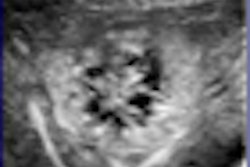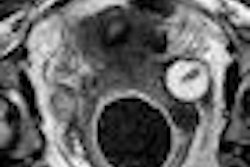Contrast-enhanced ultrasound (CEUS) bested unenhanced ultrasound and CT for detecting cancer in complex cystic renal masses, according to research from Cattinara Hospital in Trieste, Italy.
"Contrast-enhanced sonography allows reliable characterization of indeterminate cystic renal masses, and in this study it was found to perform better than unenhanced sonography and CT in the diagnosis of malignancy in complex cystic renal masses," wrote a study team led by Dr. Emilio Quaia.
The Italian researchers analyzed a series of 40 cystic renal masses with a complex pattern at contrast-enhanced CT in 40 subjects. From three to 25 days after detection, each renal mass was then scanned using sonography first without contrast material and then after intravenous injection of SonoVue (Bracco, Milan, Italy) during the arterial (15-40 seconds from injection) and venous (40-120 seconds) phases (American Journal of Roentgenology, October 2008, Vol. 191:4, pp. 1239-1249).
Ultrasound was conducted using either a Sequoia ultrasound scanner (Siemens Healthcare, Erlangen, Germany) or an EsaTune scanner (Esaote, Genoa, Italy) using a 2-5-MHz wideband convex-array transducer.
Unenhanced grayscale sonography was performed using noise- and speckle-reducing modes such as tissue harmonic and compound imaging, followed by color or power Doppler sonography with spectral analysis of peripheral and intralesional tumoral vessels. Contrast-specific imaging modes were utilized during contrast-enhanced sonography.
In consensus, two radiologists then assessed the enhancement patterns in the peripheral wall and intracystic septa, as well as evidence of solid endocystic components. Then, three blinded readers with two, six, and ten years of renal imaging experience performed a retrospective, offsite interpretation of the unenhanced sonography, contrast-enhanced sonography, and CT images, rendering a benign or malignant diagnosis according to reference diagnostic criteria.
The final diagnoses consisted of two multilocular cystic nephromas, two inflammatory and seven hemorrhagic cysts, eight uncomplicated benign cysts, and 21 cystic renal cell carcinomas, according to the authors. CEUS was found to provide higher overall accuracy than unenhanced sonography and CT.
|
||||||||||||||||||||
Contrast-enhanced sonography was better than unenhanced sonography in both diagnostic performance and confidence (p < 0.05) for all readers, according to the authors.
"Contrast-enhanced sonography had a higher diagnostic performance -- sensitivity, specificity, positive and negative predictive values, and overall accuracy -- than CT (p < 0.05) for all readers except for reader 3 who showed the same value of sensitivity for contrast-enhanced sonography and CT," the researchers wrote.
The researchers acknowledged several limitations of the study, including its retrospective nature, the lack of quantitative analysis of contrast enhancement, and the small number of lesions included in the study.
By Erik L. Ridley
AuntMinnie.com staff writer
October 3, 2008
Related Reading
Novel CAD distinguishes liver lesions on ultrasound, September 29, 2008
New society aims to secure bright future for ultrasound contrast, September 25, 2008
FDA updates ultrasound equipment guidance, September 18, 2008
Definity echo contrast agent lands on FDA drug safety list, September 8, 2008
FDA formally updates echo contrast black box warning, July 18, 2008
Copyright © 2008 AuntMinnie.com




















